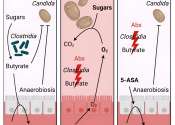Starving cancer cells to enhance DNA damage and immunotherapy response
A new research perspective titled "Starving cancer cells to enhance DNA damage and immunotherapy response" has been published in Oncotarget.
Jun 26, 2024
0
0
A new research perspective titled "Starving cancer cells to enhance DNA damage and immunotherapy response" has been published in Oncotarget.
Jun 26, 2024
0
0

Giving very premature babies high concentrations of oxygen soon after birth may reduce the risk of death by 50% compared to lower levels of oxygen, says new research led by University of Sydney researchers.
Jun 24, 2024
0
15

Researchers at University of California San Diego School of Medicine and international collaborators have led a worldwide, advanced study demonstrating the potential of tirzepatide, known to manage type 2 diabetes, as the ...
Jun 21, 2024
0
89

While many serious cases of COVID-19 are marked by respiratory distress and dangerously low blood oxygen levels—a condition referred to as hypoxia—the occurrence of "silent or happy hypoxia" affecting a subset of patients ...
Jun 18, 2024
0
1

In current clinical care, most critically-ill adults undergoing emergency tracheal intubation receive preoxygenation through an oxygen mask. Administering supplemental oxygen to patients prior to the start of an intubation ...
Jun 13, 2024
0
33

A new review paper was published in Aging titled "Peripheral vascular dysfunction and the aging brain."
Jun 12, 2024
0
0

A new high-flow oxygen technique is as safe as standard anesthetic methods during tubeless upper airway surgery in children, according to University of Queensland research. The research was published in The Lancet Respiratory ...
Jun 12, 2024
0
38

Sepsis—the leading cause of mortality in children around the world—can present with a wide range of signs and symptoms, making a one-size-fits-all treatment strategy ineffective. Pursuing a precision medicine approach ...
Jun 11, 2024
0
0

When we learn something new, our brain cells (neurons) communicate with each other through electrical and chemical signals. If the same group of neurons communicate together often, the connections between them get stronger. ...
Jun 7, 2024
0
10

A team of UC Davis Health researchers has discovered that a common anti-inflammatory drug, mesalamine, can replace the work of good bacteria in fighting the nasty fungus Candida albicans in the gut.
Jun 4, 2024
0
57

Oxygen (pronounced /ˈɒksɨdʒɨn/, from the Greek roots ὀξύς (oxys) (acid, literally "sharp", from the taste of acids) and -γενής (-genēs) (producer, literally begetter) is the element with atomic number 8 and represented by the symbol O. It is a member of the chalcogen group on the periodic table, and is a highly reactive nonmetallic period 2 element that readily forms compounds (notably oxides) with almost all other elements. At standard temperature and pressure two atoms of the element bind to form dioxygen, a colorless, odorless, tasteless diatomic gas with the formula O2. Oxygen is the third most abundant element in the universe by mass after hydrogen and helium and the most abundant element by mass in the Earth's crust. Diatomic oxygen gas constitutes 20.9% of the volume of air.
All major classes of structural molecules in living organisms, such as proteins, carbohydrates, and fats, contain oxygen, as do the major inorganic compounds that comprise animal shells, teeth, and bone. Oxygen in the form of O2 is produced from water by cyanobacteria, algae and plants during photosynthesis and is used in cellular respiration for all complex life. Oxygen is toxic to obligately anaerobic organisms, which were the dominant form of early life on Earth until O2 began to accumulate in the atmosphere 2.5 billion years ago. Another form (allotrope) of oxygen, ozone (O3), helps protect the biosphere from ultraviolet radiation with the high-altitude ozone layer, but is a pollutant near the surface where it is a by-product of smog. At even higher low earth orbit altitudes monatomic oxygen (O1) is a significant presence and a cause of erosion for spacecraft.
Oxygen was independently discovered by Carl Wilhelm Scheele, in Uppsala, in 1773 or earlier, and Joseph Priestley in Wiltshire, in 1774, but Priestley is often given priority because his publication came out in print first. The name oxygen was coined in 1777 by Antoine Lavoisier, whose experiments with oxygen helped to discredit the then-popular phlogiston theory of combustion and corrosion. Oxygen is produced industrially by fractional distillation of liquefied air, use of zeolites to remove carbon dioxide and nitrogen from air, electrolysis of water and other means. Uses of oxygen include the production of steel, plastics and textiles; rocket propellant; oxygen therapy; and life support in aircraft, submarines, spaceflight and diving.
This text uses material from Wikipedia, licensed under CC BY-SA